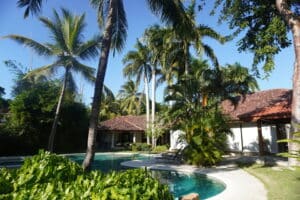Table of Contents
INTRODUCTION: Dominican Republic Culture
The Dominican Republic, located in the Caribbean, is a diverse and vibrant country with a rich cultural heritage. A blend of indigenous, African, and European influences has shaped the local culture, making it a fascinating and unique place to explore. In this article, we’ll delve into various aspects of Dominican republic culture, from its history and influences to language, food, music, art, and sports.

History and Influence
The Dominican Republic’s local culture is a reflection of its diverse history, featuring a mix of Taino, European, and African influences.
Taino Heritage
Before the arrival of Europeans, the Taino people inhabited the island of Hispaniola, where the Dominican Republic is now located. Their legacy is evident in the names of various places and even in some words and customs that have been integrated into Dominican Republic culture.
European Influence
Spanish colonization brought European culture to the island, including its language, religion, and architectural styles. The Dominican Republic was the first permanent European settlement in the Americas, and the city of Santo Domingo houses the oldest cathedral and university in the New World.
African Influence
African slaves were brought to the island during the colonial period, contributing to the development of a unique Afro-Caribbean culture. African influences can be found in Dominican music, dance, and cuisine.

Language
Dominican Spanish
The official language of the Dominican Republic is Spanish. However, the local variety, known as Dominican Spanish, is characterized by its unique accent, vocabulary, and expressions.
Unique Expressions
Dominican Spanish is peppered with idiomatic expressions and slang that may not be familiar to other Spanish speakers. For example, “¿Qué lo qué?” is a common Dominican greeting that translates to “What’s up?”
Traditional Food
Dominican cuisine is a delicious blend of Taino, Spanish, and African flavors, offering a wide range of dishes for every palate.
Popular Dishes
Some of the most popular Dominican dishes include “la bandera” (rice, beans, and meat), “sancocho” (a hearty meat and vegetable stew), and “mangú” (mashed plantains often served with fried cheese, salami, and eggs).
Street Food
Street food is also an essential part of Dominican Republic culture, with favorites such as “chimichurris” (Dominican-style hamburgers) and “empanadas” (fried pastries filled with meat or cheese).

Music and Dance
Music and dance are integral parts of Dominican Republic culture and play a significant role in social events and celebrations.
Merengue
Merengue is the Dominican Republic’s national dance and music style. It’s characterized by a lively rhythm and fast-paced movement
Bachata
Bachata is another popular music genre and dance style that originated in the Dominican Republic. Its distinct, romantic sound and slower tempo make it a favorite at parties and clubs. Bachata has gained international recognition, and artists like Romeo Santos and Juan Luis Guerra have helped popularize the genre worldwide.
Art and Crafts
Dominican art and crafts showcase the island’s history, traditions, and natural beauty.

Amber and Larimar Jewelry
The Dominican Republic culture is known for its amber and larimar, two semi-precious stones found only on the island. Local artisans create stunning jewelry pieces with these unique stones, making them popular souvenirs for visitors.
Faceless Dolls
One of the most emblematic crafts in the Dominican Republic is the “muñeca sin rostro,” or faceless doll. These ceramic dolls represent the mix of Taino, African, and European cultures, as their facelessness signifies the blending of different races.
Religious Traditions
Religion plays a significant role in the Dominican Republic culture, with the majority of the population identifying as Roman Catholic. Religious traditions and celebrations are deeply ingrained in the local culture.
Patron Saint Festivals
Each town in the Dominican Republic has a patron saint, and annual festivals are held to celebrate these saints. These festivities, known as “fiestas patronales,” often include processions, live music, food, and dancing.

Holy Week Celebrations
Holy Week, or “Semana Santa,” is another important religious event in the Dominican Republic culture. During this time, many Dominicans attend church services, participate in processions, and take part in traditional activities such as the burning of Judas effigies.

Sports
Sports are a significant aspect of Dominican Republic culture, and baseball reigns supreme as the national sport.
Baseball
Baseball is incredibly popular in the Dominican Republic, and many Dominicans have become successful professional players in Major League Baseball (MLB). The island has produced renowned players like David Ortiz, Pedro Martinez, and Vladimir Guerrero.
Cockfighting
Cockfighting, though controversial, is another popular sport in the Dominican Republic. It has deep historical roots and is considered a cultural tradition in some regions of the country.

Conclusion: Dominican Republic Culture
The Dominican Republic’s local culture is a captivating mix of indigenous, African, and European influences. With its rich history, unique language, diverse cuisine, lively music and dance, stunning art and crafts, and a strong connection to religious traditions and sports, the Dominican Republic offers an immersive cultural experience for both visitors and locals alike.
FAQs
- What is the Dominican Republic’s official language? The official language of the Dominican Republic is Spanish, specifically Dominican Spanish.
- What are some popular dishes in Dominican cuisine? Some popular dishes in Dominican cuisine include la bandera, sancocho, and mangú.
- What are the main music styles in the Dominican Republic? Merengue and Bachata are the main music styles in the Dominican Republic.
- What are some traditional Dominican crafts? Amber and larimar jewelry and faceless dolls are examples of traditional Dominican crafts.
- What is the national sport of the Dominican Republic? Baseball is the national sport of the Dominican Republic.
The Dominican Republic is a Caribbean paradise known not only for its stunning beaches and lush landscapes but also for its rich and vibrant local culture. A melting pot of influences, the culture here is a unique blend of African, Taino, and Spanish heritage. From music and dance to food and festivals, the Dominican Republic offers a cultural experience that is as diverse as it is captivating. In this article, we explore the key elements that define the local culture of this beautiful island nation.
Historical Influences
The history of the Dominican Republic is a tapestry woven with the threads of its indigenous Taino people, African slaves, and Spanish colonizers. This mix has created a distinct cultural identity. The Taino influence is evident in various crafts and traditional practices, while African roots are deeply embedded in the island’s music, dance, and religious practices. Spanish colonial influence is reflected in the architecture, language, and many aspects of daily life.
Music and Dance
Music and dance are the heartbeats of Dominican culture. Merengue and bachata are the most famous music genres originating from the Dominican Republic, each with its own distinct style and rhythm. Merengue, recognized for its fast-paced, joyful beats, often features instruments like the accordion, tambora, and güira. Bachata, on the other hand, has a more romantic and melancholic sound, typically played with guitars. Both genres are celebrated with lively dance styles that are integral to Dominican social life.
Traditional Cuisine
Dominican cuisine is a delightful blend of Taino, African, and Spanish flavors. Staple ingredients include plantains, rice, beans, and a variety of meats and seafood. One of the most iconic dishes is “La Bandera Dominicana” (The Dominican Flag), consisting of rice, beans, and meat, often accompanied by salad and fried plantains. Other popular dishes include “Sancocho,” a hearty stew, and “Mangu,” mashed green plantains usually served with fried cheese, eggs, and salami for breakfast. The use of fresh, local ingredients makes Dominican food both flavorful and wholesome.





